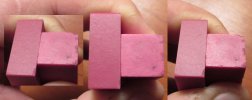failbot
Gold Member
- Joined
- Aug 9, 2013
- Messages
- 245
He is clearly from this box, inscription '#214 fine'. But it is quite old, perhaps the technology is improving. Now I will compare with another sample, newer, I recently received from a friend. As far as I remember, medium and fine now differ only in surface treatment, the composition is the same.failbot Would you say that the general color of your sample in RL looks very much like the color in the digital photo image?
i have chinese rubies which match the color in your jpeg but my Degussit Fine units have a much darker red color (like a cherry red).
maybe your unit isn't Fine but Medium, whaddya think?
So far, the color side by side of the old one is lighter, but here the processing is still F230, after processing F600 it will be possible to judge the color. A coarser sanded surface is always lighter, this is very noticeable on black Arkansas.



